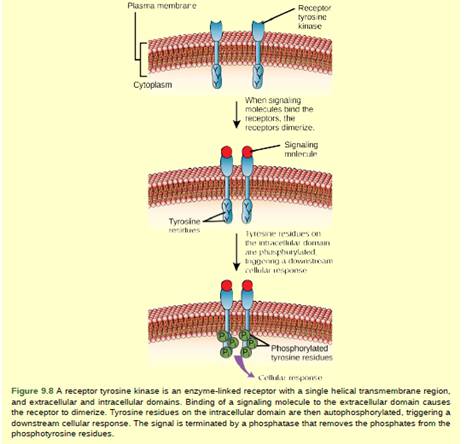
Concept explainers
Figure 9.8 HER2 is a receptor tyrosine kinase. In 30 percent of human breast cancers, HER2 is permanently activated, resulting in unregulated cell division. Lapatinib, a drug used to treat breast cancer, inhibits HER2 receptor tyrosine kinase autophosphorylation (the process by which the receptor adds phosphates onto itself), thus reducing tumor growth by 50 percent. Besides autophosphorylation, which of the following steps would be inhibited by Lapatinib?
- Signaling molecule binding, dimerization, and the downstream cellular response.

Introduction:
Enzyme-linked receptors are the cell-surface receptors with intracellular domains that are associated with an enzyme. They normally have large extracellular and intracellular domains. The family of human epidermal growth factors receptor (HER) including the HER1, HER2, HER3 and HER4 play a central role in the pathogenesis of many human cancer.
Answer to Problem 1VCQ
Correct answer:
The correct answer is option (c)The downstream cellular response.
Explanation of Solution
Explanation/justification for the correct answer:
Option (c)The downstream cellular response. HER2 receptor is a 1255 amino acid, transmembrane glycoprotein. It is located on the long arm of the human chromosome 17 and its expression causes uncontrolled cell growth. This receptor undergoes dimerization on binding of the signaling molecule to the extracellular domain. This results in the process of autophosphorylation of the tyrosine residues on the intracellular domain which initiates a downstream cellular response. Lapatinib is a drug which inhibits the autophosphorylation of the tyrosine residues, thus inhibiting the process of downstream cellular response. So, the correct answer is option (c).
Explanation for incorrect answer:
Option (a)Signaling molecule binding, dimerization, and the downstream cellular response. The binding of a signaling molecule to the extracellular domain of the receptor causes dimerization initiating a downstream cellular response. So, this is an incorrect option.
Option (b)Dimerization, and the downstream cellular response. The processes such as dimerization and the downstream cellular response are not inhibited due to the binding of a signaling molecule to its extracellular domain. So, this is an incorrect option.
Option (d) Phosphatase activity, dimerization, and the downstream cellular response. It also exhibits phosphatase activity causing the removal of phosphates and termination of the signal after dimerization and downstream cellular response. So, this is an incorrect option.
Thus, Lapatinib is a drug which inhibits the process of downstream cellular responseapart from autophosphorylation.Hence, the correct answer is option (c) The downstream cellular response.
Want to see more full solutions like this?
Chapter 9 Solutions
Biology 2e
Additional Science Textbook Solutions
College Physics
Biological Science (6th Edition)
Campbell Essential Biology (6th Edition) - standalone book
Biology: Life on Earth (11th Edition)
Campbell Biology (11th Edition)
Campbell Biology: Concepts & Connections (9th Edition)
 Human Anatomy & Physiology (11th Edition)BiologyISBN:9780134580999Author:Elaine N. Marieb, Katja N. HoehnPublisher:PEARSON
Human Anatomy & Physiology (11th Edition)BiologyISBN:9780134580999Author:Elaine N. Marieb, Katja N. HoehnPublisher:PEARSON Biology 2eBiologyISBN:9781947172517Author:Matthew Douglas, Jung Choi, Mary Ann ClarkPublisher:OpenStax
Biology 2eBiologyISBN:9781947172517Author:Matthew Douglas, Jung Choi, Mary Ann ClarkPublisher:OpenStax Anatomy & PhysiologyBiologyISBN:9781259398629Author:McKinley, Michael P., O'loughlin, Valerie Dean, Bidle, Theresa StouterPublisher:Mcgraw Hill Education,
Anatomy & PhysiologyBiologyISBN:9781259398629Author:McKinley, Michael P., O'loughlin, Valerie Dean, Bidle, Theresa StouterPublisher:Mcgraw Hill Education, Molecular Biology of the Cell (Sixth Edition)BiologyISBN:9780815344322Author:Bruce Alberts, Alexander D. Johnson, Julian Lewis, David Morgan, Martin Raff, Keith Roberts, Peter WalterPublisher:W. W. Norton & Company
Molecular Biology of the Cell (Sixth Edition)BiologyISBN:9780815344322Author:Bruce Alberts, Alexander D. Johnson, Julian Lewis, David Morgan, Martin Raff, Keith Roberts, Peter WalterPublisher:W. W. Norton & Company Laboratory Manual For Human Anatomy & PhysiologyBiologyISBN:9781260159363Author:Martin, Terry R., Prentice-craver, CynthiaPublisher:McGraw-Hill Publishing Co.
Laboratory Manual For Human Anatomy & PhysiologyBiologyISBN:9781260159363Author:Martin, Terry R., Prentice-craver, CynthiaPublisher:McGraw-Hill Publishing Co. Inquiry Into Life (16th Edition)BiologyISBN:9781260231700Author:Sylvia S. Mader, Michael WindelspechtPublisher:McGraw Hill Education
Inquiry Into Life (16th Edition)BiologyISBN:9781260231700Author:Sylvia S. Mader, Michael WindelspechtPublisher:McGraw Hill Education





